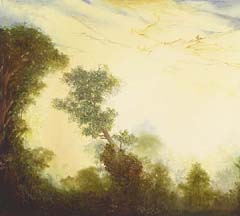Dinora Felske Justice
ART NEW ENGLAND Feb/Mar 2004 - Susan
Boulanger
Dinora
Felske Justice, a young artist from Brazil, uses the luminous materiality
of oil paint to capture nature’s
solace. The twenty-nine works gathered at the Kantar Gallery demonstrate
Justice’s ability to meld classical technique and modern sensibility
in paintings of mesmerizing richness.
Juxtaposing
Renaissance precision and techniques (such as scumbling and glazing)
with an abstract, modern treatment – by
way of the Turner of Rain, Steam, and Speed – of broad
areas of light and color, Justice unites classical atmospheric illusionism
with patterned surfaces asserting modernist immediacy and objectness.
This subtle pull creates a vitalizing tension and urgency that gives
a powerful edge to the works’ dreamlike quality. In Qeimada
III, drifting gray-white mists heightened with citron and violet
rise from wind-brushed grasslands to obscure encircling woodlands.
The image conveys transcendent beauty and anonymous familiarity, timelessness
and transformation, narrative and silence.
The
coincident Rembrandt show at the Museum of Fine Arts, Boston, underscores
both Justice’s association with and
divergence from the Old Master tradition. Whereas Rembrandt’s
landscapes seemingly extend for miles, even Justice’s most panoramic
works, the Amazonia series, for example, forego vastness for
enveloping intimacy. Most revealing is the contrast between Rembrandt’s
landscapes, which abound with signs of human enterprise, and Justice’s,
in which no human presence is indicated, only the art object’s
implicit creator and viewer.
Rembrandt
places humankind – farmers, children,
lovers – at the world’s center. His explorations of nature
incorporate humanity’s relation to it, and each natural motif
has its contiguous human artifact: farmhouse, bridge, boat. Humans,
however, no longer feel superior to nature or take their exploitation
of it as an unquestionable, benign right or necessity. Justice’s
serenely empty landscapes invoke a time before and after human occupation.
Her avowed respect and concern for nature is superbly served by her
ability to both render and imagine its impenetrable, vulnerable beauty.
The
Hauntingly
Beautiful Landscapes
Of Dinora Felske Justice
By Barbara Rizza Mellin *
Newton-based artist Dinora Felske Justice believes every artist has one particular
subject that compels him/her to paint. For Justice, that subject is landscapes. “There
is a perfect marriage of the universal and personal in the depiction of
nature,” she says. But, nature and landscapes are more than just
pretty scenes for this artist. Rather, she is referring to the “all-encompassing
presence” that she contends is the “character of space and
its depiction.” Her paintings are simultaneously real and ethereal.

|
Sinfonia Natural IV |
Justice, whose mother was an art educator, has been creating art
since early childhood in her native Brazil. She studied with renowned
artists Wilson Alves, Ernest Frederico Scheffel and Ariadne Decker
before coming to the United States. Here, she earned a Certificate
in Graphic Design from the School of the Museum of Fine Arts, Boston,
and a degree in Fine Arts from the Art Institute of Boston, where
she was Valedictorian of the Class of 2001.
Justice
claims the evolution of her artistic style has quickened its pace
in the past two years. Her canvases “have
become more metaphorical,” she says, “moving toward imaginary
landscapes that are more personal and almost spiritual.” As a
result, Justice feels her work, now created with “less constraints,” is “not
just a record of the physical phenomenon,” but rather “more
transcendental.”
Justice
draws on her rich visual memories of her homeland, as well as impressions
of her adopted country, to provide inspiration for her landscapes.
She observes nature on long walks, often photographing specific elements
for future reference or making value sketches along the way. She
then recomposes and changes the arrangement of natural elements to
comprise a wholly new imaginative landscape, which she creates in
oil on canvas. Since she never includes man-made objects, her compositions
evoke a peaceful timelessness. Amazonia
III, for example, is an imaginative interpretation of
places seen and remembered.
Like
the artists who have influenced her – Casper David Friedrich and Joseph William
Turner – Justice actually paints light and air.
The
quality most striking in her work is the atmospheric presence that
permeates the space. The viewer can almost feel the depth of the
scene as an ever-present atmosphere envelopes the elements and
blurs distances.
To
achieve this effect in her art, Justice applies the layering techniques
of ancient Dutch masters.
“It is a form of indirect painting,” she
says, “where you build up a perception of depth by glazing or
scumbling.” Glazing – overpainting with a transparent color – adds
a “jewel-like luminosity” to the area, while scumbling – the
overpainting of an area with matte, opaque pigments – tends to
soften the edges, to create a rich, dense illusion of atmospheric space. “It
is actually a retinal phenomenon,” she explains, “allowing
us to perceive color differently.”
Often working on three
canvases at a time (to allow for slow-drying oil paints), Justice likes
to juxtapose the techniques. In Pantanal I,
a hauntingly beautiful oil painting in hues of greens
and blues, the background is expressive in its diffused
representation, while the foreground is detailed, communicating
more directly with the viewer.
Justice
composes her landscapes by positioning images to “produce
a penetrating, yet slightly unconventional effect.” To achieve
this result, the artist often begins with a small (2”x4”)
pencil mock-up of the paintings, showing the compositional position
of key elements and the value structure of lights and darks. Later,
after the painting is more than halfway completed, she sometimes creates
another mock-up (approximately 4”x4”) in color on gesso
paper, to help solve any problems that may have arisen with the original
design. For example, while working on one landscape with a tree on
the left-hand side and a large area of warm golden sky in the opposite
quarter, Justice decided the composition needed more interest, but
she didn’t want to add another tree. After recreating the painting
in miniature, she experimented with possible solutions. Ultimately,
she solve the problem by adding a blue-gray cloud mass that balanced
the strength of the trees and cooled the color of the sky, all the
while contributing drama to the scene.
It would
be easy for Justice to concentrate exclusively on her well-received
oil paintings, but the creative spirit within her
compels her to explore new areas of expression and communication.
Her current fascination is with the possibility of three-dimensional
representations of space. She is developing installations that allow
the viewer to wander through landscape images – paintings of various widths suspended from
the ceiling and painted on two sides. Justice first explored this concept
in her senior project at the Art Institute of Boston at Lesley University,
where she was awarded the senior prize for painting. Anthony Apesos,
head of the MFA program at AIB, observed “the conceptual and
formal issues of these [installations] were explored with invention
and intelligence.” Her 3-D landscapes, says Justice, are both “a
psychological and physical space, encompassing, as in nature.” She
sees the art community as stagnant in its limited, exclusively two-dimensional
representations of landscapes. Justice would like to create a three-dimensional
installation that “challenges and expands the whole idea of art
and space.”
Whether
in her two-dimensional paintings or three-dimensional installations,
landscapes remain the compelling subject for this artist, and those
who view her work are the beneficiaries of her compulsion.
Kantar Fine Arts presents
an exhibition of Dinora Felske Justice's oil paintings, Add It
All Up, Then Simplify, from October 10 - November 7,
2004. On Thursday evening, October 21, 7:30pm,
at the gallery, Ms. Justice will discuss the meaning of the title
of this exhibit, especially as it applies to her current paintings. Justice’s
artwork can also be seen at her Upcoming Exhibitions:
November - December
2004 Groton Public Library
June 2005 – Newton
Free Library Gallery
*reprinted with permission of
Middlesex Beat, September2003, Featured Cover Artist & pg. 14
and 15
Winner of The Middlesex Beat Contest ~ "The
Middlesex Beat gave me a tough assignment as juror since only one person
could walk away with the prize. Quite simply, there was too much
compelling work from which to choose...
"It was this ...quality of conjuring up the essential while purifying
the elements represented that ..characterizes the paintings of Dinora
Felske Justice. Justice's landscapes transport the viewer to a safe
haven where our senses are delighted and our spirit is gently renewed.
There is a soothing, mystical quality to her work. And yet, it is not
only the emotional nature of her paintings that distinguishes her work,
technically she also has mastered her medium. Though Justice relies on
old master techniques to create her paintings, her vision is uniquely
her own. One anticipates much from this young artist, whose mature style
and expression already is notable and worthy of commendation."
Rebecca Reynolds, the former Jean S. and Frederic A. Sharf
Fellow of American Decorative Arts and Sculpture at the Museum of
Fine Arts, Boston, currently holding a Luce Fellowship and completing
her dissertation on Anna Hyatt Huntington for Boston University. (More
Here)

